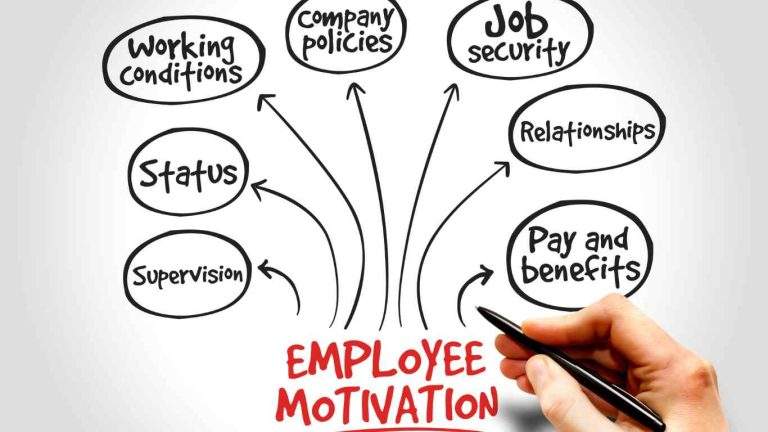Measures to manage and motivate my employees.
As a business owner, managing and motivating your employees is an essential component of running a successful business. It requires dedication, patience, and understanding to inspire your employees to perform at their best. Identifying the appropriate measures to manage and motivate employees can enhance their productivity, efficiency, and job satisfaction, leading to a more successful business. In this article, we will take a look at ActionCOACHes 14 points of management. Our aim is to support you to become a great manager, a manager that makes a difference. A strong manager for the people that will differentiate your business from the majority. This is all about driving productivity and the performance of your business by having employees that are motivated, productive, and highly engaged with you and your journey to your vision. These points can be applied equally to your extended team, the people that you manage through your outsourcing partners and agencies.
To allow and enable your team to take responsibility & ownership.
Top Tip:
Document routine processes.
As a leader, it is important to allow and enable your team to take responsibility and ownership of their work. This fosters a sense of autonomy and empowers team members to take initiative and be accountable for their actions. One way to do this is to delegate tasks and projects with clear expectations and goals, while also providing necessary support and resources. The key to delegating effectively is to have your routine processes documented. If they are not then you will be destined to have to keep doing the task yourself.
Clear, written, discussed, shared roles & responsibilities.
Top Tip:
Define Job Descriptions for all your employees.
Clear, written, discussed, and shared roles and responsibilities are critical in achieving organizational success.

When team members understand their roles and the responsibilities associated with them, they are more likely to work cohesively toward achieving shared goals. Written and shared roles and responsibilities provide a structure that enables team members to align their efforts and stay on track. Discussing roles and responsibilities can help identify areas of overlap or potential conflicts, enabling teams to address them proactively. When roles and responsibilities are clear, team members can work more efficiently, reducing time spent on duplicate efforts or misunderstandings. Additionally, when responsibilities are shared, it enables greater flexibility and adaptability when one team member is absent or unable to complete a task.
Join the NoLimits Business Community
Are you a business owner looking to take your business to the next level? Join our innovative community of like-minded professionals and gain access to a wealth of valuable resources, including a community portal to chat with other business owners, ebooks, business development software, and growth events that will transform the way you do business. Best of all, these resources are completely free and will be available to you forever.
But the benefits of joining our NoLimits business community don’t stop there. By becoming part of our community, you’ll have the opportunity to connect with other business owners, share insights and ideas, and build valuable relationships that will help your business thrive. Don’t miss out on this amazing opportunity to supercharge your business and join us today!
Create a line of sight.
Top Tip:
Clearly defined company, team, and individual goals.
Motivating employees is an essential task for any successful business. One strategy to motivate employees is to create a line of sight. This means connecting the employee’s individual goals and objectives, such as personal growth and achievement, to the company’s overall mission and success. Giving employees a clear understanding of how their efforts contribute to the company’s success can boost their motivation and inspire them to work harder. Providing clear, specific, and achievable goals, as well as regular feedback and recognition, can be essential for creating a line of sight. This will help employees see the direct connection between their work and the company’s success, and in turn, they will feel more engaged and motivated to work towards achieving company goals. By creating a line of sight, managers can help unlock the full potential of their employees, and ultimately drive the business forward.
Work the team…then work the problem.
Top Tip:
Team meetings; warm up the team first, discuss the problem second, and solve it together.
We are people first and problem solvers second. When faced with a problem, it’s important to first work on building a cohesive team before addressing the problem itself. This means developing trust, fostering open communication, and encouraging each member to contribute their ideas and perspectives. Once the team is working together smoothly, then they can turn their focus toward the problem at hand. With a strong team in place, the problem-solving process becomes more effective, and the solutions generated as a team tend to be more innovative and impactful. Therefore, it’s important to remember that teamwork is the foundation for success in any organization and to prioritize building a strong team before tackling any problems or obstacles.

The top management priority…the well-being and success of the team.
There has been a momentous shift towards making the well-being of your employees a priority since the beginning of this decade. A happy and productive team is essential for the success of any organization. Studies have shown that when employees are engaged and motivated, they are more productive, committed, and less likely to leave the organization. Therefore, managers need to invest time and resources into ensuring their employees’ well-being by providing a healthy work-life balance, creating a positive work environment, offering training and development opportunities, recognizing and rewarding good performance, and listening and responding to employees’ feedback. This can lead to increased job satisfaction, higher retention rates, and ultimately, greater success for the organization. By making the well-being and success of the team a top priority, managers can create a culture of success and happiness that benefits everyone.
1:1s… are to help your team grow. Prepare for them. Be generous with your time.

Top Tip:
Invest quality time in regular 1:1s with all your direct reports.
As a leader, 1-on-1 meetings with your team members can be one of the most powerful tools in your arsenal.
These meetings are an opportunity to build trust, foster growth, and address any issues and concerns that your team members may have. To make the most of these meetings, it’s important to prepare for them beforehand. Identify any areas of concern that you want to discuss and come up with a list of questions that will help guide the conversation. Additionally, be generous with your time during these meetings. Show your team members that you are invested in their success by giving them your undivided attention and active listening. By prioritizing 1-on-1 meetings and being intentional about how you approach them, you can help your team members grow and ultimately drive success for your organisation.
Confront the elephant – embrace it, own it.
Top Tip:
Do not let any elephants in your team go unaddressed.
Confronting the elephant means acknowledging the uncomfortable truths or situations in our lives. In other words, it’s essential to face the problems and issues head-on rather than avoiding them. Embracing it means accepting it as a crucial part of our lives and recognize that it’s okay to make mistakes. Owning it means taking control of the situation and finding a way to overcome it. Confronting the elephant requires bravery and courage, but it’s essential for personal growth and development. By accepting our problems and challenges, we can come up with solutions that will help us move forward. It’s important to remember that it’s okay to struggle and face difficult situations, but it’s the way we handle them that defines us. Embracing the elephant and owning it will lead to resilience and ultimately success.
Listening is the number 1 skill.
Top tip:
Ask a question, and listen with your ears, eyes, and heart.
Listening is often overlooked as an essential skill, but it is the number one skill in reducing resistance. When people feel heard, understood, and respected, they are more willing to cooperate and less likely to resist.

Active listening is a powerful tool that involves paying attention to what the other person is saying, clarifying any misunderstandings, and providing feedback. It is not just about hearing the words that are spoken but also about understanding the meaning behind them. As individuals, we all have our own unique perspectives, experiences, and emotions, and by listening actively, we can gain a better understanding of others’ points of view. When we approach conversations with an open mind and a genuine interest in what others have to say, we create an environment of trust and respect. In doing so, we reduce resistance and increase the likelihood of achieving our goals.
Believe in your people more than they do…
and help instill courage.
Top Tip:
Believe in your people, what’s the opposite – not believing in them?
As a leader, it is important to believe in your people more than they do in themselves. Often, individuals underestimate their own abilities and potential. It is the responsibility of the leader to help instill courage in their team members and encourage them to strive for greatness. By believing in their employees and showing confidence in their abilities, leaders can inspire them to reach their full potential. This can create a positive workplace culture where team members feel valued and motivated to work hard. Leaders who invest time and effort in developing their team can create a strong sense of loyalty and commitment among employees, leading to greater success for the organization as a whole. By instilling courage and confidence in their employees, leaders can create a dynamic, high-performing team that can achieve great feats.

Encourage your people to be themselves.
Encouraging your people to be themselves is essential for creating a positive and authentic work environment. When employees feel comfortable expressing their true selves, they are more likely to be creative, innovative, and engaged.
As a leader, it is important to foster an environment that embraces diversity and inclusivity. This means creating a workplace culture that values every individual’s unique skills, experiences, and perspectives. One way to encourage this is by recognizing and celebrating differences among team members. Encourage employees to share their hobbies, interests, and backgrounds. This not only fosters a sense of belonging but also helps colleagues to see each other as multidimensional individuals. Ultimately, when people feel accepted and appreciated for who they are, they are more likely to be productive, committed, and motivated. So, as a leader, it is important to create a safe and supportive space that encourages people to be their authentic selves.
People who feel good about themselves perform.
Top Tip:
Remember this simple acronym (MMFISH) Make Me Feel Important Safe & Happy.
People who feel good about themselves tend to perform better in various aspects of their lives. This is because they possess a positive self-image and a healthy sense of self-esteem, allowing them to approach challenges and tasks with confidence and a can-do attitude. This level of self-assurance enables them to push past their comfort zones and take on new opportunities with ease. When faced with setbacks or failures, these individuals are more resilient and able to bounce back and try again. In addition, they are typically more motivated to pursue their goals and achieve success, as they believe in their own abilities and worth. Overall, feeling good about oneself can have a profound effect on one’s performance and can lead to personal and professional growth.
What gets measured gets done. What you reward gets done again.
Top Tip:
This starts with having Key Performance Indicators (KPIs).
The phrase “What gets measured gets done” is a popular management saying that refers to the idea that people are more likely to put priority on tasks that are being tracked or monitored. When managers or supervisors create clear goals with measurable objectives for their employees, it provides a sense of accountability and urgency to get things done. Furthermore, “What you reward gets done again” means that when individuals see others being recognized and rewarded for their hard work, they are more likely to repeat those same behaviors to receive similar recognition. Rewards can take many forms, such as bonuses, promotions, or simple public recognition. Regardless of the form, the end result is the same: individuals are more motivated to achieve their goals when they know they will be acknowledged for their efforts. Ultimately, both sayings go hand in hand, emphasizing the importance of not just setting measurable goals, but also rewarding and recognising achievement along the way to encourage consistent progress.

20:60:80 – REMIND REMIND REMIND.
Top Tip:
Use this 20:60:80 reminder system.
20:60:80 – REMIND REMIND REMIND is a simple management principle to aid your delegation to make sure that tasks are completed on time. It involves reminding your team member at 3 distinct points along the timeline of the task/activity. At 20%, 60%, and 80%. So, for example on a 10-day activity:
On day 2 – 20% into the deadline – ask ‘Just checking on how you are getting on?’
On day 6 – 60% into deadline – ‘Just checking that you are on track’.
On day 8 – 80% into the deadline ‘just making sure it is going to be completed on time’.
When you are working for something bigger than yourself…you grow.
Top Tip:
Define your company vision and purpose statements.
Working in a team towards a bigger and greater goal can be a truly transformative experience. It allows individuals to push themselves beyond their limits, take on new challenges, and grow both personally and professionally. When you work towards something bigger than yourself, you are forced to operate outside of your comfort zone and become more adaptable, resilient, and creative in finding solutions to problems. Additionally, working in a team typically means working with people who have different perspectives, backgrounds, and skill sets than your own. This diversity fosters an environment of learning and growth where each team member has the opportunity to learn from one another and push themselves to acquire new skills and knowledge. By defining and working together towards your company’s inspiring vision and purpose – the reason why your business exists, individuals can achieve something that would be impossible on their own, and in the process, they can become better, more capable human beings.
By Natalie Simms
Join the NoLimits Business Community
Are you a business owner looking to take your business to the next level? Join our innovative community of like-minded professionals and gain access to a wealth of valuable resources, including a community portal to chat with other business owners, ebooks, business development software, and growth events that will transform the way you do business. Best of all, these resources are completely free and will be available to you forever.
But the benefits of joining our NoLimits business community don’t stop there. By becoming part of our community, you’ll have the opportunity to connect with other business owners, share insights and ideas, and build valuable relationships that will help your business thrive. Don’t miss out on this amazing opportunity to supercharge your business and join us today!

